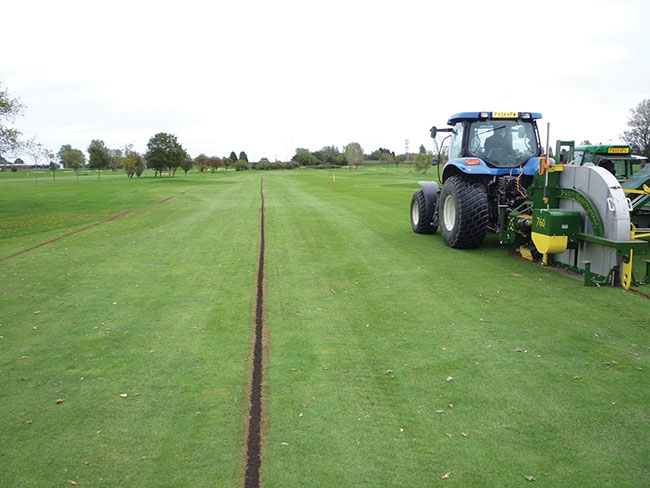
Features
Drainage Management Systems
Draining fairways
Seven steps to successful fairway drainage.
May 5, 2015 By Mick Claxton
 The Supertrencher+ 760 carries out fairway drainage. Few soils will drain fast enough to allow golf to be played in comfort after a period of prolonged rain
The Supertrencher+ 760 carries out fairway drainage. Few soils will drain fast enough to allow golf to be played in comfort after a period of prolonged rainFew soils will drain fast enough to allow golf to be played in comfort after a period of prolonged rain, but effective drainage techniques can make a huge difference to the speed at which water will drain away. Here are seven steps for successful fairway drainage that will keep costs down.
1. Tile depth
The size and correct positioning of the tile is vital, as it has the job of drawing the moisture elsewhere. Many golf courses are built on clay soils, which are almost impermeable to moisture, so excess water will simply sit on top of it. For best results lateral tiles should be approximately 19 inches deep and main drains should be about 23 inches deep. Installing tiles even seven to 11 inches deeper can be a waste of money. Drains placed too close to the surface can be damaged by future surface aeration operations.
2. Tile layout
The “flag layout” gives the best results for fairway drainage, as the main drain runs down the side of the fairway – possibly in the rough – and the junctions are clear of the closely mown areas. This method gives better results than the traditional “herringbone layout” where water is taken to the centre of the fairway, where most golfers will be playing.
3. Tile spacing
Cost is generally the major factor when deciding how far apart to place lateral drains, but a spacing of 32 feet would be considered the maximum, while 22 feet or 16 feet are preferable spacings on the wetter parts of the course. Spacing can be wider if a secondary drainage system is superimposed over the tile system.
4. Tile size
Size is important, but bigger isn’t better when it comes to land drainage. Plastic land drainage tiles have small slits cut into them so the water can flow into the tile – as this happens, it takes fine soil particles with it. Where there is a good flow of water, these particles are flushed away. This can be helped by using a smaller tile of one, two or three inches in diameter. In larger tiles, where water flow is more sluggish, the soil particles will simply sit in the bottom and create a build up, reducing effectiveness.
5. Trench size
The most cost-effective technique is to cut a trench that is slightly wider than the diameter of the pipe. The forces in the soil will close the trench walls 0.5 to 0.75 inches soon after digging, allowing the tile to fit snugly in the trench. Many modern sportsturf trenching machines work on the same principles as a large circular saw, cutting trenches with considerable precision. Paying close attention to the size of the trench can result in a big cost saving as less aggregate is required to backfill the trench.
6. Fall
It may sound obvious that water doesn’t flow uphill, but all your good work can go to waste if tiles do not have adequate fall on them, allowing the water to run away. Specialist contractors use laser-guided machines to ensure tiles are installed at greater depths through mounds and ridges.
7. Timing
The best advice has got to be to, “plan the work when it’s wet and do it when it’s dry.” Working in wet soils creates damage to the soil structure, but waiting until things dry up a bit means drainage work can be carried out speedily, so there is minimal disruption and greater recovery.
On heavy soil or courses in wetter areas, a secondary system may need to be installed for the best results, but a well-installed primary tile system is a cost-effective first step and can achieve great results. DC
Shelton Sportsturf Drainage Ltd is a global business based near Horncastle in Lincolnshire, England. Shelton designs and manufactures specialist drainage machinery engineered with sportsturf in mind, leaving minimal impact on grass so it can get back in play within 24 hours of work being completed. For more information contact www.sheltonsdrainage.com.
Print this page